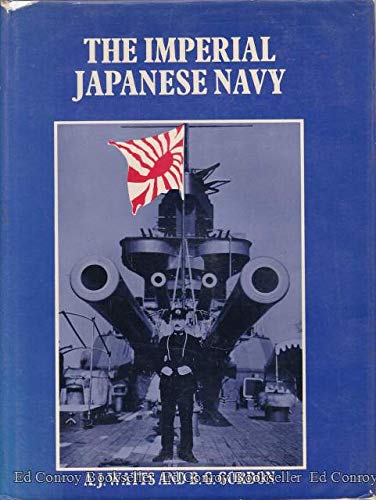Download The Imperial Japanese Navy PDF Free - Full Version
Download The Imperial Japanese Navy by Anthony J. Watts, Brian G. Gordon in PDF format completely FREE. No registration required, no payment needed. Get instant access to this valuable resource on PDFdrive.to!
About The Imperial Japanese Navy
<p>A latecomer on the international naval scene, Japan did not begin to build up her Navy until the 1870s. Relying first on foreign-built warships, the Japanese spared no effort to acquire the necessary knowledge to construct their own vessels and, within a few decades, the new Imperial Japanese Navy was already a highly efficient force.</p><p><br></p><p>The acid test of fire came in 1904 when, to country the increasing Russian political interference in the Far East, the Japanese High Command decided on a surprise strike against the Russian Fleet in Port Arthur. This was followed on May 27, 1905, by the 'Japanese Trafalgar' when the numerically superior Russian Baltic Fleet was annihilated at Tsushima by Japanese naval forces under Admiral Togo.</p><p><br></p><p>After the First World War the Imperial Japanese Navy went through a series of naval construction and modernisation programmes, first copying certain foreign design features but soon evolving an original style of their own. Although the Washington Treaty of 1922 set certain limits on the size and number of naval units, Japanese designers soon found ways and means of circumventing these restrictions. But it was not just an expansion in numbers and size: along with the US Navy the Japanese Naval High Command were the first to recognise the future offensive capabilities of aircraft carriers and the long-range striking power of carrier-borne aviation, and drew the correct conclusions.</p><p><br></p><p>By 1941 the Imperial Japanese Navy was a modern and well-balanced force, ready to face any adversary, and its growing strength played an important part in the plans of the Japanese High Command, The Japanese naval striking power was concentrated in a group of aircraft carriers equipped with modern attack aircraft and fighters (including the then phenomenal Zero), crewed by highly trained airmen, and supported by several flotillas of fast and far-ranging cruisers, destroyers and large submarines. The nucleus consisted of a strong force of heavily armed and armoured battleships, including the world's largest units of the type.</p><p><br></p><p>This enormous power was unleashed on December 7, 1941, when the Japanese carrier-borne aviation and midget submarines struck at the US Naval base in Pearl Harbor.</p><p><br></p><p>For a while it seemed that there was nothing that could stop the Japanese onslaught but, despite the initial successes, the Imperial Japanese Navy did not have the necessary industrial backing for prolonged sea warfare and could not compete with the growing Allied sea and air power. Within a few short years the once powerful and proud force had been reduced to a shadow of its former self and was never given the chance to recuperate.</p><p><br></p><p>There was much originality in the design of later Japanese warships and these vessels were as good--and in some case, even better--than their Allied counterparts. The development of Japanese naval architecture is a fascinating story, although parts of it can never be told owing to the wholesale destruction of essential original documents in 1945.</p><p><br></p><p>The narrative is the result of 15 years of painstaking research work by A. J. Watts and B. G. Gordon and represents the first extensively detailed and accurate survey of the Imperial Japanese Navy from its inception to its destruction in 1945, spanning a period of 70 years of Japanese warship development. The authors have had access to many hitherto unpublished documents and files from Japanese, American and British sources, and their highly detailed narrative is illustrated by several hundred selected photographs and accurate line drawings.</p></br></br></br></br></br></br></br>
Detailed Information
| Author: | Anthony J. Watts, Brian G. Gordon |
|---|---|
| Publication Year: | 1971 |
| ISBN: | 385012683 |
| Pages: | 529 |
| Language: | other |
| File Size: | 154.751 |
| Format: | |
| Price: | FREE |
Safe & Secure Download - No registration required
Why Choose PDFdrive for Your Free The Imperial Japanese Navy Download?
- 100% Free: No hidden fees or subscriptions required for one book every day.
- No Registration: Immediate access is available without creating accounts for one book every day.
- Safe and Secure: Clean downloads without malware or viruses
- Multiple Formats: PDF, MOBI, Mpub,... optimized for all devices
- Educational Resource: Supporting knowledge sharing and learning
Frequently Asked Questions
Is it really free to download The Imperial Japanese Navy PDF?
Yes, on https://PDFdrive.to you can download The Imperial Japanese Navy by Anthony J. Watts, Brian G. Gordon completely free. We don't require any payment, subscription, or registration to access this PDF file. For 3 books every day.
How can I read The Imperial Japanese Navy on my mobile device?
After downloading The Imperial Japanese Navy PDF, you can open it with any PDF reader app on your phone or tablet. We recommend using Adobe Acrobat Reader, Apple Books, or Google Play Books for the best reading experience.
Is this the full version of The Imperial Japanese Navy?
Yes, this is the complete PDF version of The Imperial Japanese Navy by Anthony J. Watts, Brian G. Gordon. You will be able to read the entire content as in the printed version without missing any pages.
Is it legal to download The Imperial Japanese Navy PDF for free?
https://PDFdrive.to provides links to free educational resources available online. We do not store any files on our servers. Please be aware of copyright laws in your country before downloading.
The materials shared are intended for research, educational, and personal use in accordance with fair use principles.

